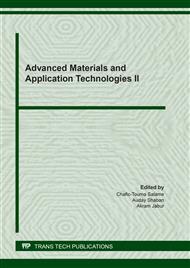[1]
S. Formosinho, and M. eds.Barroso, Proton-coupled electron transfer: a Carrefour of chemical reactivity traditions. Royal Society of Chemistry. (2011).
DOI: 10.1039/9781849733168
Google Scholar
[2]
H.M. Obeed, and H.J. Al-Agealy, Investigation and studied of charge transfer processes at HATNA and HATNA-Cl6 molecules contact with Cu metal. AIP Conference Proceedings 2292(1) (2020) 040010.
DOI: 10.1063/5.0030518
Google Scholar
[3]
S.S. Al-Obaidi, H.J. Al-Agealy, and S.R. Abbas, Investigation And Study Of Electronic Transition Current For Au Metal Contact With Pentacene Molecule. Solid State Technology, 63(6) (2020) 8780-8789.
Google Scholar
[4]
H.J. Al-Agealy, and M.Z. Fadhil, M.Z., Electron Transfer At Metal/Molecule Interface. Ibn AL-Haitham Journal For Pure and Applied Science, 26(3) (2017) 86-93.
Google Scholar
[5]
H.J. Al-Agealy, and H.H.D.A. Janeri, Investigation the flow charge rate at InAs/D149 and ZnO/D149 system using theoretical quantum model. AIP Conference Proceedings 2123(1) (2019) 020055.
DOI: 10.1063/1.5116982
Google Scholar
[6]
H.J.M. Al-agealy, and J.S.H. Al-Hakany, Theoretical Calculations of Rate Constant of Electron Transfer Across N3/TiO2 Sensitized Dye Interface Solar Cell. Ibn AL-Haitham Journal For Pure and Applied Science, 25(2) (2017). 160-169.
DOI: 10.30526/2017.ihsciconf.1766
Google Scholar
[7]
M. Hollerer, D. Lüftner, P. Hurdax, T. Ules, S. Soubatch, F. S. Tautz, G. Koller, P. Puschnig, M. Sterrer, and M. G. Ramsey, Charge transfer and orbital level alignment at inorganic/organic interfaces: The role of dielectric interlayers. ACS nano, 11(6) (2017) 6252-6260.
DOI: 10.1021/acsnano.7b02449
Google Scholar
[8]
Y.R. Shi, and Y.F. Liu, Theoretical study on the charge transport and metallic conducting properties in organic complexes. Physical Chemistry Chemical Physics, 21(24) (2019) 13304-13318.
DOI: 10.1039/c9cp02170a
Google Scholar
[9]
R. Jitchati, Y. Thathong, and K. Wongkhan, Three synthetic routes to a commercial N3 dye. International Journal of Applied Physics and Mathematics, 2(2) (2012) 1076.
DOI: 10.7763/ijapm.2012.v2.64
Google Scholar
[10]
N. Kouki, S. Trabelsi, M. Seydou, F. Maurel, and B. Tangour, Internal path investigation of the acting electrons during the photocatalysis of panchromatic ruthenium dyes in dye-sensitized solar cells. Comptes Rendus Chimie, 22(1) (2019) 34-45.
DOI: 10.1016/j.crci.2018.10.009
Google Scholar
[11]
B. Nourozi, A. Aminian, N. Fili, Y. Zangeneh, A. Boochani, and P. Darabi, The electronic and optical properties of MgO mono-layer: Based on GGA-mBJ. Results in Physics, 12 (2019) 2038-2043.
DOI: 10.1016/j.rinp.2019.02.054
Google Scholar
[12]
R. Q. Ghadhban, H. J. Al-Agealy, and M. A. Hassooni, Theoretical Analysis of the Electronic Current at Au/PTCDA Interface. NeuroQuantology, 18(9) (2020) 81.
DOI: 10.14704/nq.2020.18.9.nq20220
Google Scholar
[13]
F. T. Vasko, and O. E. Raichev, Quantum Kinetic Theory and Applications: Electrons, Photons, Phonons. Springer Science and Business Media. (2006).
Google Scholar
[14]
H. M. Obeed, and H. J. Al-Agealy, Investigation and studied of charge transfer processes at HATNA and HATNA-Cl6 molecules contact with Cu metal. AIP Conference Proceedings, 2292(1) (2020) 040010.
DOI: 10.1063/5.0030518
Google Scholar
[15]
W. J. Royea, A. M. Fajardo, and N. S. Lewis, Fermi golden rule approach to evaluating outer-sphere electron-transfer rate constants at semiconductor/liquid interfaces. The Journal of Physical Chemistry B, 101(51) (1997) 11152-11159.
DOI: 10.1021/jp972222y
Google Scholar
[16]
H. J. AL-Agealy, T. S. AlMaadhede, M. A. Hassooni, A. K. Sadoon, A. M. Ashweik, H. A. Mahdi, and R. Q. Ghadhban, Theoretical study of electronic transfer current rate at dye-sensitized solar cells. AIP Conference Proceedings 1968(1) (2018) 030055.
DOI: 10.1063/1.5039242
Google Scholar
[17]
H. J. Al-agealy, Theoretical Study of the Electronic Transition Rate Production in Alq3 molecule With Au Metal Interface. IOP Conference Series: Materials Science and Engineering 871(1) (2020) 012093.
DOI: 10.1088/1757-899x/871/1/012093
Google Scholar
[18]
I. Smallwood, Handbook of organic solvent properties. Butterworth-Heinemann, (2012).
Google Scholar
[19]
K. Hirota, N. Okabayashi, K. Toyoda, and O. Yamaguchi, Characterization and sintering of reactive MgO. Materials research bulletin, 27(3) (1992) 319-326.
DOI: 10.1016/0025-5408(92)90061-4
Google Scholar
[20]
N. S. Lewis, Progress in understanding electron-transfer reactions at semiconductor/liquid interfaces (1998).
Google Scholar
[21]
B. Nourozi, A. Aminian, N. Fili, Y. Zangeneh, A. Boochani, and P. Darabi, The electronic and optical properties of MgO mono-layer: Based on GGA-mBJ. Results in Physics, 12 (2019) 2038-2043.
DOI: 10.1016/j.rinp.2019.02.054
Google Scholar
[22]
M. Adachi, M. Sakamoto, J. Jiu, Y. Ogata, and S. Isoda, Determination of parameters of electron transport in dye-sensitized solar cells using electrochemical impedance spectroscopy. The Journal of Physical Chemistry B, 110(28) (2006) 13872-13880.
DOI: 10.1021/jp061693u
Google Scholar
[23]
P. Cendula, S. D. Tilley, S. Gimenez, J. Bisquert, M. Schmid, M. Grätzel, and J. O. Schumacher, Calculation of the energy band diagram of a photoelectrochemical water splitting cell. The Journal of Physical Chemistry C, 118(51) (2014) 29599-29607.
DOI: 10.1021/jp509719d
Google Scholar


